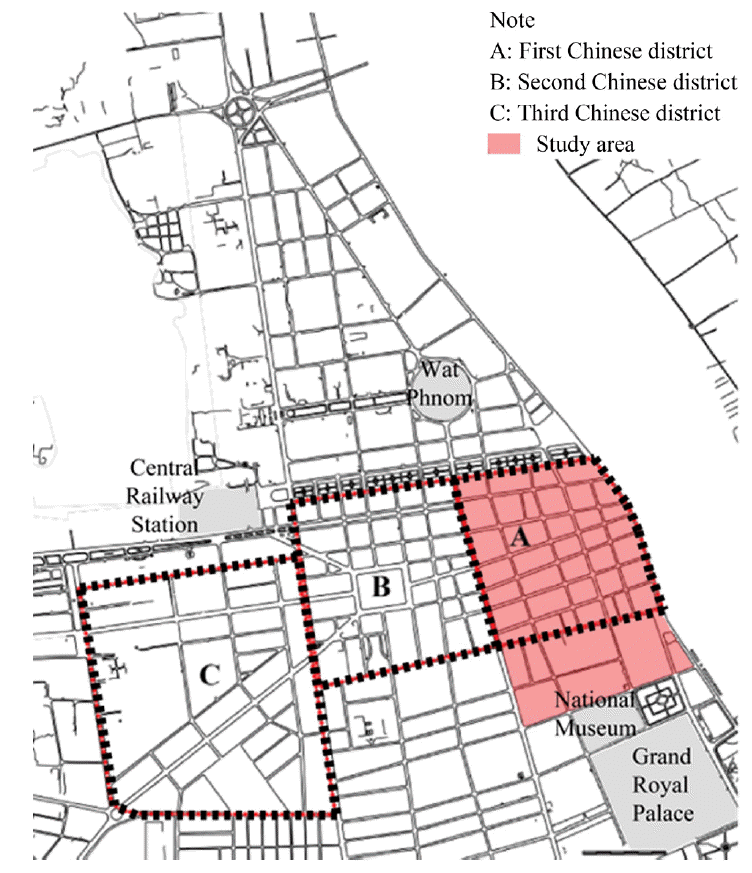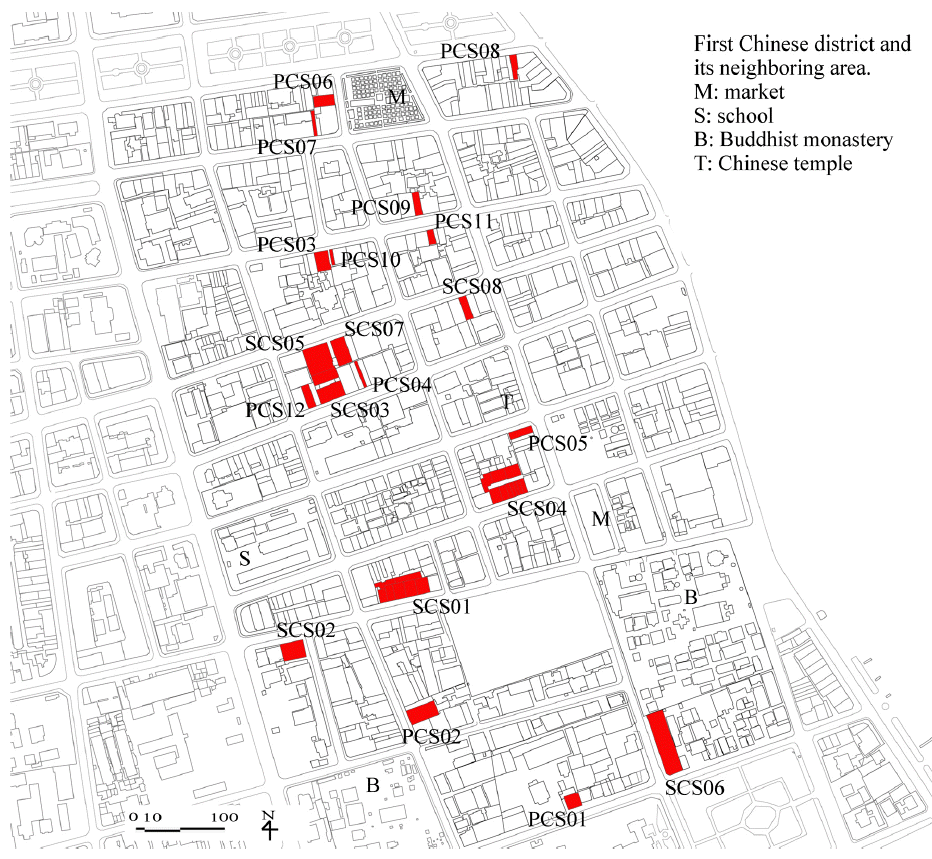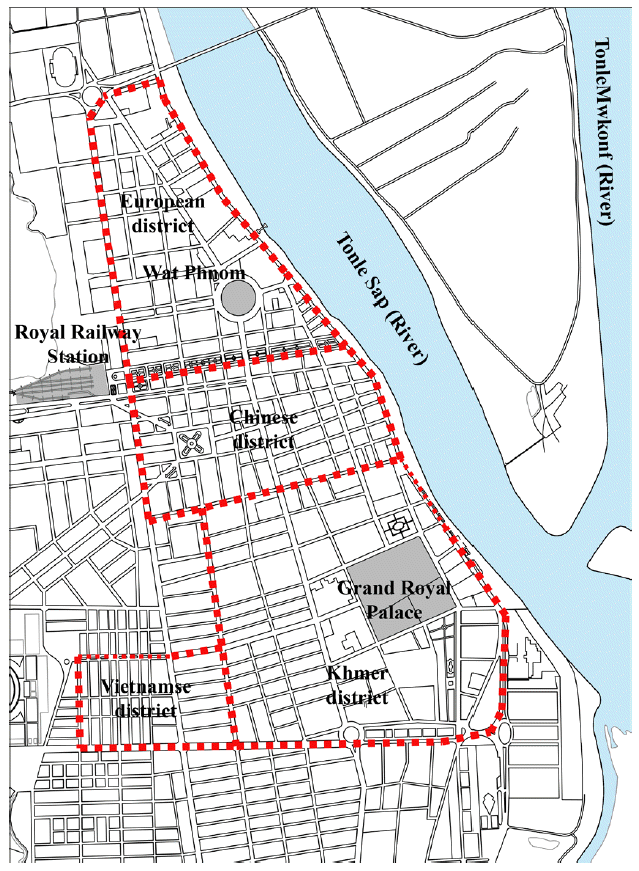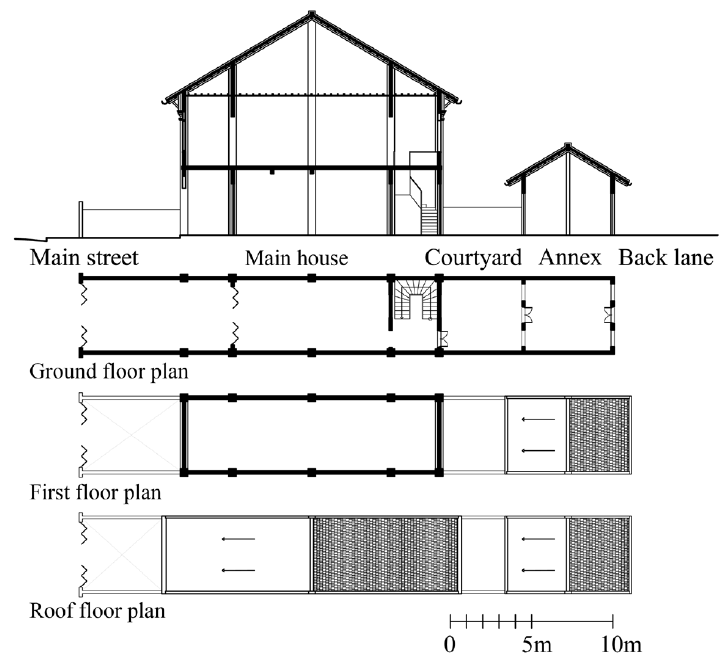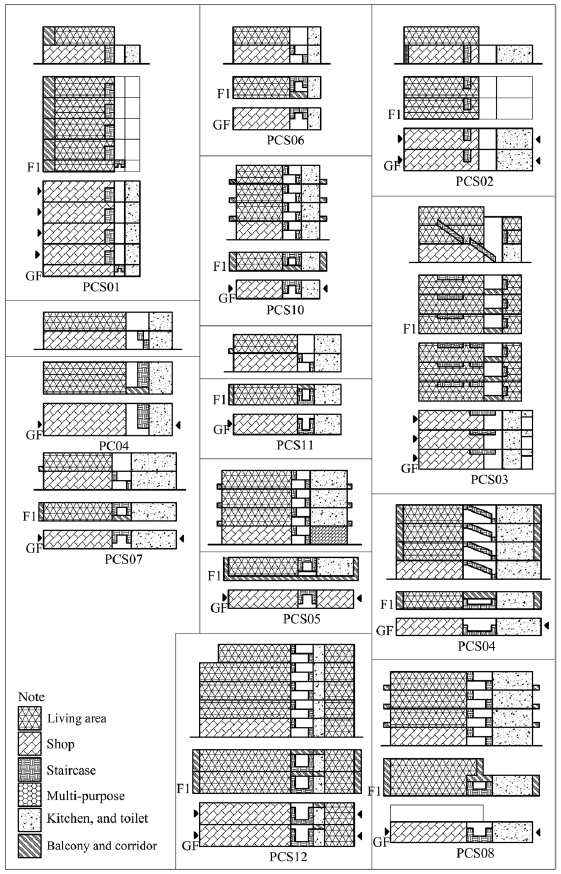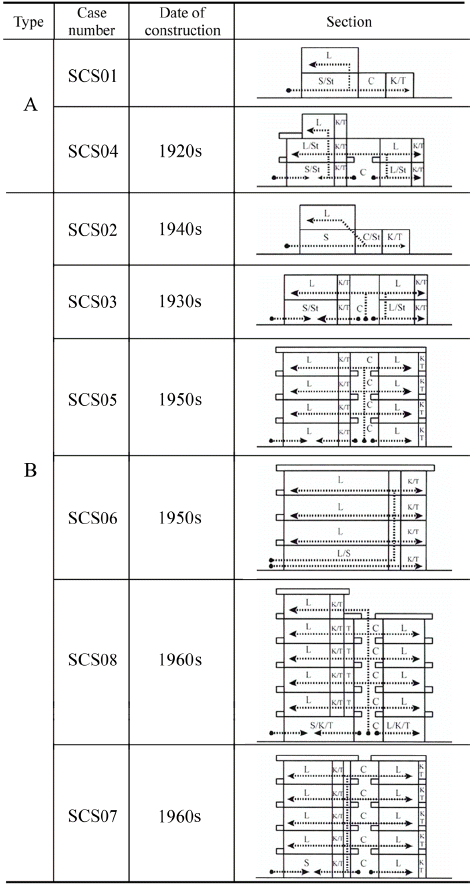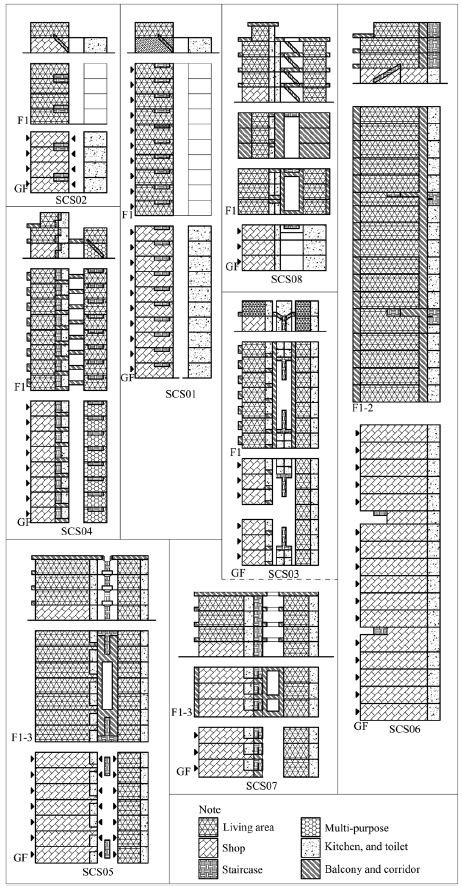Introduction
1. Background and Aims of Study
The shophouse is a unique feature found broadly in major Southeast Asian cities. Shophouses are tenement buildings with shops on the ground floor and living quarters on the upper floors [16]. These buildings were originally built on narrow and long plots and grouped as urban blocks in Chinese districts. The shophouse can be defined as a representative typology of urban housing developed by Chinese merchants and immigrants who moved to colonial cites and built their dwellings as a grouped community [7].
In Phnom Penh, the capital city of Cambodia, the Chinese population accounted for 76.51% of the total population, and Phnom Penh was one of the largest Chinese communities in Indochinese cities [15]. Shophouses are major urban buildings that accommodate commercial and residential functions at the same time. In the Chinese district around Phsar Thmey for example, the central market, thousands of blocks of shophouses are located (Figure 1).
Throughout the phases of urban development of Phnom Penh, this archetype has progressively evolved due to Western influences as well as advancements in building technology, particularly the development of concrete structures in the 1930s, the emergence of cultural influences, and the massive increase in urban population. As a result of this evolution, a new form of shophouse called the ‘apartment type shophouse,’ which cannot be found in other Southeast Asian cities, was developed and settled as a popular dwelling type in Phnom Penh.
In the ‘apartment type shophouse,’ a multiple bay shophouse, courtyards were united and shared by individual units, and one main staircase was located in a common courtyard. On the other hand, in traditional shophouses (single bay houses), courtyards are separated by walls and used individually for one unit only. This study attempts to identify the ‘apartment type shophouse’ found in Phnom Penh and tracks the transformation process from the historic shophouse to the modern shophouse.
By analyzing 20 shophouses in the first Chinese district in Phnom Penh (Figure 2), this study attempts to investigate the spatial organization of shophouses based on the original building form rather than newly added space or remodeled spaces.
The main purpose of this study is to trace the transformation process of shophouses that were built in Phnom Penh during 1920s-1960s. Through this analysis, this study attempts to identify the main changes and the causes of those changes. Finally we anticipate that this study addresses the uniqueness of shophouses in Cambodia; an issue that has not yet been clearly defined.
2. Research Scope and Methodology of Study
This study aims to identify the space organization of shophouses in the early Chinese districts of Phnom Penh, where diverse stocks of shophouses still exist today. The houses were analyzed in terms of three major aspects: (1) basic house data (construction year, length of plot, plot ratio, ratio of main components, number of storeys, number of units, and number of bays), (2) urban block analysis, and (3) unit analysis. For the urban block analysis, we studied the main entrance into the block and the circulation system elements such as corridors, staircases, bridges and balconies. For the unit analysis, we studied unit ownership, kitchen and toilet location, and the relations between the units and the courtyard.
The methodology adopted in this study is the qualitative analysis of 20 shophouses selected according to construction period; two cases in the 1920s, three cases in the 1930s, two cases in the 1940s, four cases in the 1950s, and nine cases in the 1960s. We cannot select even cases according to period because the majority of shophouses of today Phnom Penh was built in the 1960s and early shophouses were disappeared during the French Protectorate time. We conducted field surveys and interviews with residents during the period between August 2013 and February 2014. Documentation was conducted through photographing, sketching and field measurements. Regarding the year of construction, we made best guesses based on the recollection of resident neighbors and other related articles such as old maps, postcards and interview with some survivors who were familiar with architecture to confirm the date of construction, as it is one of the most critical variables for this research work.
Urban Development of Phnom Penh
Since Phnom Penh is located where Mekong and Tonle Sap rivers meet, it developed as a commercial route that connects Malay and Batavia to China [10, 13]. Many Chinese immigrants moved to Phnom Penh and were assimilated into Cambodian culture both economically and socially, and those immigrants mainly worked in agriculture and fishing [17]. According to Henri Mouhot’s report, which is the first report about Phnom Penh written in 1859, the major population of the city at that time was Chinese; roughly one quarter of the total population was Chinese, and the rest consisted of Vietnamese, Siamese, Malays, Indians, and Filipinos [17].
Under the French protectorate in 1865, Phnom Penh became the new capital and started to develop along the waterfront of the Tonle Sap. The Royal Palace was newly built using masonry structure. Later on, modern masonry construction began to proliferate in Phnom Penh. Due to the rapid influx of the population, King Norodom hired the French contractor, Le Faucheur, in 1872 and instructed him to construct three hundred Chinese masonry shophouses, known as compartiments chinois; this started the first wave of shophouse construction [17].
In 1884, Phnom Penh municipality was founded, the monopoly rights by the King were abolished, and a new system of land ownership was established [13]. In 1889, Huynh de Verneville, Resident Superieur of Cambodia, divided the city according to the ethnicity and profession such as Quartier European (French administrative district), Quartier Chinois (Chinese commercial area), and Quartier Cambodgien (local administration district) (Figure 3) [2]. This layout is still present in modern days and is recognized as a unique feature of the city.
In the 1890s, street patterns were fixed and major canals were constructed. Major administration buildings were built along the canals. After the great fire in 1894, which destroyed most of the wooden buildings, Phnom Penh forced new buildings to be built in masonry structures [13]. Hundreds of masonry shophouses were built along the new roads and grand boulevards. These shophouses comprised commercial activity on the street level and residential use in the upper floors and since then became recognized as typical buildings in Phnom Penh.
In 1914, King Sisowath succeeded King Norodom and started a new era to expand the city. The Protectorate controlled the city’s development by collecting taxes, building schools, and filling in more lakes. During this development, investors preferred apartment type shophouses than European style buildings [17].
In 1923, the second era of grand planning was executed by the town planner Ernest Hebrard, a new Indo-China Urbanization Directorate. In the 1930s, Hebrard built the new grand market, Phsar Thmey (new market), in the center of the Chinese district in order to control trades [6]. This market has functioned as a commercial center, and is surrounded by a hundred blocks of shophouses.
During the period between the First World War and the Great Depression (between the 1920s and late 1930s), Phnom Penh went through a significant expansion [13]. As Boeung Decho (Decho lake) and canals were filled, the topography of the city changed significantly. During this expansion, blocks of shophouses proliferated in the second Chinese district (Figure 3). As concrete and the Art Deco style began to emerge, they significantly influenced the era’s architecture. The Art Deco style was applied to most of the major public buildings such as Phsar Thmey and Hotel Le Royal, characterize the cityscape of Phnom Penh today [17].
Between the 1940s and 1953, Phnom Penh’s cityscape remained relatively unchanged. The first generation of shophouses which were built at the end of the 19th century became old and deteriorated. These old buildings failed to accommodate the rapidly increasing population.
After independence in 1953, Phnom Penh experienced another significant modernization (Figure 4). As the city expanded westward, the third Chinese district was constructed and expanded towards the west as well. Social housing projects, government complexes, sports facilities, and educational facilities were designed to express a strong sense of new national identity [14]. To solve the rapid population growth in the city, the government and private investors began to actively replace old two-storey colonial shophouses with multi-storey concrete shophouses. Nevertheless, these new multi-storey apartment type shophouses maintained some of their traditional features; they remained to have long and narrow forms, and maintained commercial activities on the street level and residential use in the upper floors. After the replacement, the three or four storey apartment type shophouses represented typical architecture in cities.
After the political instability caused by the civil war during the period 1970-1975, the Khmer Rouge, who took over the country, massacred the population and wiped out the city. Despite the Khmer Rouge’s violence, fortunately the significant buildings survived and remained untouched [17].
Definition of Shophouse
The shophouse is a unique urban housing typology found in Chinese districts of Southeast Asian historic cities.
The origin of shophouse is the Song Dynasty (960-1279) in China [4]. After the rise of Maritime Silk Road, the navigation made China and Southeast Asia for a ground floor and residential purpose for an upper floor. Shophouses were built along streets with uniform facades in a grid pattern of urban blocks [8].
The term “shophouse” varies from one country to another. In Malaysia, shophouse refers to the same meaning mentioned above. The shophouse in Malaysia is generally two or three storeys high and has two or three internal courtyards (was later reduced to an air well when space became more precious) and yard at the rear of shophouses [3].
In Vietnam, the shophouse is called the ‘tube house,’ ‘street house’ or ‘Nha Ong,’ and is built on narrow and very deep plots where widths are 2-4 meters and lengths are 20-60 meters [9, 12]. The ‘tube house’ implies the physical tube form, which means that the length must be much longer than the width, commonly at least 5 times (preferably over 10 times). The uniqueness of a tube house is that it consists of separate masses and void spaces. These masses and void spaces are connected by bridges or long corridors on one side of the building [12].
In Cambodia, the shophouse is called “Pteas Lvaeng,” which refers to a ‘bay house’ and implies how it is built. The shophouse is also called “Pteas Tiam,” which refers to a house with a shop to imply the function of the building. According to Blancot and Goldblum [1], a shophouse in Cambodia refers to the same notion of shophouses as in other Southeast Asian cities, where it is aligned along the road and divided by a shared masonry wall, composed of two different parts; commercial on the ground floor and residential in the first floor.
The more detailed aspects of shophouses in Cambodia were given by the Heritage Mission’s report [5] on shophouses in Siem Reap. According to this report, the shophouse is composed of a main house, a courtyard, and an annex. The main house is composed of one or two stories, and the facade is largely open to the public and facing the main street. In the facade, a gallery (five-footway) is used as a transitional space between the street and the main building, as well as to protect pedestrians from both the sun and rain. The courtyard offers daylight and ventilation inside of the house. The annex building, which is usually composed of only one level, serves as storage and for sanitation purposes, and works as complementary habitation space. The annex building is normally located at the back of a shophouse and faces the back lane. The construction is based on a 4 m-width bay composed of a simple structure with brick supporting wall, a wooden floor and staircase as well as the roof structure, covered with clay roof tile. The various compositions of the main building, courtyard, and annex determine the typology of a shophouse. This definition gives us a clear explanation for both the function and basic spatial organization of shophouses in Siem Reap. However, the report does not cover a variety of shophouses that were built in other cities, where it only focused on early shophouses in Siem Reap.
If we compare between the different shophouses in Southeast Asia (Figure 5), shophouses in Malaysia and Vietnam are composed of several masses and voids, where the main house confronts the main street and several annexes are located in the middle and at the rear. Courtyards are in the form of air wells rather than a typical courtyard, except for the rear courtyard. On the other hand, shophouses in Cambodia are composed of only three components such as one main house, one courtyard, and one annex. Shophouses in Cambodia and Malaysia share a similar configuration, where rooms are arranged along one single axis. The rooms of the tube house in Vietnam, however, are connected by means of one side corridor.
Based on the result of this study, the shophouses in Phnom Penh were classified into two categories according to the status of the courtyard, such as private courtyard shophouse (PCS) and shared courtyard shophouse (SCS), as stated below.
1. Private Courtyard Shophouse
PCS is a single bay shophouse, where the space is limited in one bay and is structurally separated from adjacent buildings by a shared wall. This is the archetype of the early shophouse. It contains a highly private space, particularly the courtyard. Traditionally PCS exclusively accommodates a single family (Figures 6, 7). However, the modern PCS, which is usually reconstructed after demolishing the old shophouse, accommodates many units, usually one unit per floor, by sharing a common staircase and corridor in the courtyard.
2. Shared Courtyard Shophouse
SCS is composed of a group of single bay shophouses (ranging from 3 to 17 bays). SCSs were either built after demolishing some parts of early shophouse blocks which consisted of multiple bay buildings, or newly constructed as a block with a shared courtyard, public courtyard or corridor. The only 1 case (SCS06) has a shared corridor and without courtyard, and SCS08 has an individual courtyard in the ground floor, which is not the subject of this study. PCSs, however, never share courtyards even though they were built as multiple span block buildings. The SCS accommodates more units per floor (Figures 8, 9). The ownership of the unit was transformed from a full-length occupation to a half-length occupation.
Analysis
1. Overview of Cases
Among all the 20 selected cases, 12 cases are classified as PCS and eight cases as SCS. The construction years of the cases varies: two cases (1920s), three cases (1930s), two cases (1940s), four cases (1950s), and nine cases (1960s).
Based on the analysis of general status of the cases, we found that the early shophouses which were built between 1900s-1920s, were built as two storey buildings, with brick bearing walls and wooden floors. The transitional shophouses, built between 1920s-1940s, were built as two storey buildings too but with reinforced concrete floors. The modern shophouses, built between 1940s-1970s, were constructed as higher buildings up to six floors and built with reinforced concrete column-beam structures and concrete floors.
The early PCS was built as a multiple-span independent block building (PCS01 and PCS02), whereas the PCS built between 1950s-1960s were mainly built as single span buildings, with only two cases (PCS03 and PCS08) built as multiple-span. The development of the PCS in the modern period was led by smaller developers in a very confined space. Whereas SCSs were built as building blocks with larger spans; they are ranged from 3 spans to 17 spans. All PCSs and only four cases of early SCS (SCS01, SCS02, SCS04, and SCS06) were designed to have full-length units, where each unit occupied the full length of the plot. The modern SCSs were built as double loaded building blocks or half-length unit, which each span hosts two units, consisting of a front unit and back unit, a shared corridor, staircase and courtyard. The modern SCS had more capacity to host more units, and was more suitable for a high-density city (Table 1).
Each of the cases was built with a varied plot ratio due to the limitation of irregular urban block patterns. The plot ratio of the cases ranges from 1:4.7 (PCS06) to 1:9.2 (SCS04). An average of plot ratio is 1:5.6 for the PCSs and 1:7.05 for the SCSs. Therefore the ratio of SCS is larger than PCS. However, the ratios for PCS and SCS between the three main components of the house (main house, courtyard, and annex) are quite similar: 1:0.32:0.42 (PCS) versus 1:0.33:0.43 (SCS) (Figure 10). In case of the shared courtyard (SC03, SC05, and SC07), the space ratio of the annex is shown as increased up to .64-.72 due to the back unit being used as a separate unit from the main house.
All shophouses are aligned to the main street in a row, and the main entrance is generally from the front. PCSs are typically designed to have a back entrance in order to provide an extra entrance except for PC01 which has only one front access. However, the SCSs typically provide a shared side access into the courtyard rather than the back access. Only SC03 has a sole front access. Having only one access however is not a safe design. This prototype disappeared from the later built shophouses because of building regulation requirements.
The location of the staircase is another significant feature. The staircase of early PCS (PCS01 and PCS02) is located in the main house (shop area). Staircases of transitional and modern PCS, however, were moved into the courtyard to provide more space to the shop area at the ground level and also provide more space for the upper level. In addition, it allowed for more daylight and ventilation for the courtyard. In the SCS, the locations of staircases are varied. Staircases of early SCSs (SCS01 and SCS02) were typically located only in the main house (shop area), and the staircase was a straight staircase. The straight staircase located in the shop area was popular until the 1950s, but it disappeared and was replaced by the U-shape staircase, which requires less space. It was typically located at the back of the main house and faced the courtyard to obtain more daylight and ventilation. Staircases of modern SCS were located in the central courtyard, where it could gain maximum daylight and ventilation. In addition, this layout of staircases could reduce the number of staircases while increasing the number of units in a building.
2. Private Courtyard Shophouse
The space organization for PCSs could simply be classified into two types according to the location of staircases connecting the ground floor and the upper floors.
In type A, which is comparatively an early shophouse, staircases are located in the main space connecting the ground floor and the upper floors (PCS01 and PCS02). The shop area of type A has dual functions; (1) commercial use and (2) to connect from the ground floor to the upper floor by a straight or U-shaped staircase. If the building was higher than two storeys, a bridge was necessary to connect the main space and annex (PCS03). In type B, however, which was built later after the 1950s, staircases became located in the courtyard and mostly designed as U-shaped staircases, as they require less space (PCS04, PCS06, PCS07, PCS08, PCS09, PCS10, PCS11, and PCS12). We could infer that one of the reasons for locating staircases in the courtyard is to allow for more space to the shop area and convenience for residents who live in the upper units (Figure 11).
The courtyard in the early PCS served as a ventilation and light well to overcome the bad conditions of the narrow and deep plot. In shophouses built during 1940s-1960s, various staircases and utility pipes were introduced. As a result, courtyards were transformed from simple air wells into utility spaces and community spaces by centralizing residents’ paths (Figure 12).
The units in PCS are full length units where each unit occupies the full length of the plot, composed of three main components; the main house, courtyard, and annex. The main house is composed of a shop area at the ground level and a living area in the upper floor, a courtyard containing a stair and corridor, and an annex comprised of extra living area, or kitchen and toilet. In the first floor level, the main house and annex are typically accessed via the courtyard where the staircase is located. Inside the main house, there is no division of interior space in all PCS cases we surveyed. This open layout provides more flexibility for use of space. In addition, it indicates that the upper floor serves not only as a living area but also as a multi-purpose space. In the event of increase of commercial activities in the area, the second floor or any floor above the ground floor could be used as a shop, restaurant or office, as we can observe easily from today’s activities.
3. Shared Courtyard Shophouse
The typologies of the SCSs are diverse compared to PCS in most aspects. The space organization of SCS can be classified into two types according to the location of staircases connecting the ground floor and the upper floor. In type A, staircases are located in the main house and link the ground floor to the upper floor (SCS01 and SCS04), which is the most typical configuration found in earlier periods and other countries. In type B, which was mostly built since the 1950s, staircases were relocated to the shared courtyard and designed with a diverse staircase typology, including straight staircases (SCS02), T-shaped staircases (SCS03 and SCS05), L-shaped staircases (SCS08), U-shaped staircases (SCS07), and multi-staircases (SCS06). The advantage of type B is that it gives more space for shops in the ground floor as well as privacy and convenience for residents who live in the upper floors (Figure 13).
The main entrances into the building blocks for residents are generally located in side alleys because they usually consist of multiple bays. But in the case of SC03 and SC06, the main entrances are accessed from the main streets, which empty one span of the whole building block. Interestingly in SCS, they cannot be accessed from back lanes.
The courtyard of the early SCS acted as a ventilation device, provided daylight into each unit and served as a community space because all the residents shared a single courtyard at the ground level and could approach their units via common staircases, corridors and sometimes bridges which connected main spaces and annexes. Since the 1940s, the one side corridors which connect each unit in parallel appeared as common. The corridors were installed on both sides of the main space and annex instead of connecting individual the main space and annex by bridges, which is a quite common design in modern double loaded high rise apartments in Southeast Asia (Figure 14).
The courtyard of the SCS built in later periods became larger than before and allowed for ventilation, daylighting, common access, storage, public toilets, and sometimes parking and extra shops. Early SCSs have only two access points to the block in the front and side.
In early SCS (SCS01, SCS02), one unit used the full length of a bay. The presence of a mezzanine floor in a unit and the separate use of front (main space) and back space (annex) in a single bay started to appear in the 1940s. In the case of a full-length unit, the space organization of a unit is the same as that of the PCS unit. In half-length unit cases, however, where one unit occupies only the main space or annex for living (SCS03, SCS05, SCS07, and SCS08), the kitchen and toilet which are usually located on the side are located at the back of the unit. The front units which used the main space, kitchens and toilets are located in the courtyard side. On the other hand, the back units which used the annex for independent living space, kitchens and toilets are located at the end of the building block (SCS05 and SCS07). In the case of SCS08, the toilet of the back unit is attached to the front unit and there is no kitchen. The combination of the two toilet spaces of the front and back units became typical after the introduction of plumbing systems. Although it worked in favor of space efficiency, there was a lack of privacy for residents.
The living space in a unit is multi-purpose, as it is used as a guest area during the day time and family living space and a space for sleeping during the night time. Typically it is an open space rather than being separated into smaller rooms, except for SCS03 where the bedroom is separated from the living area.
Conclusion
The shophouse is a unique feature of historic Southeast Asian cities. Shophouses have been modernized over time to reflect the environmental, cultural and historical context in which they existed. In Phnom Penh, shophouses are considered yet the most popular dwelling typology. Various typologies of shophouses have been developed throughout the years due to modernization, socioeconomic changes and new emergent technologies in Cambodia.
As a result of the analysis, 20 shophouses in Phnom Penh were classified into two types; private courtyard shophouse (PCS) and shared courtyard shophouse (SCS).
PCS is the typology that maintains most of the characteristics of early shophouses. In modern PCSs, which were usually reconstructed after demolishing old shophouses, staircases were located in the shop area at an early period but moved to the courtyard to share with units located in the upper floors at a later period of time. As the height of the building increased from two storeys to three-four storeys, they could accommodate many units. But they keep the principle that the single unit occupied the full length of a bay per a floor.
SCS is the typology constructed as a block (or multiple span building). In early SCSs, the basic space organization of PCSs was maintained except for the fact that they did not have walls between bays. As SCSs increased in height, staircases moved to the courtyard and were shared with the increasing number of units in the upper floors, and corridors and bridges were introduced to connect units in the same floor. The size and number of shared courtyards has increased by time. These prototypes were quite similar to the western multi-family housing typology; which consisted of a double loaded type apartment with an atrium in the center. Regarding unit ownership, half-length unit prototypes, where one family used only half the length of a bay (front or back unit), have become popular since the 1940s.
Both PCS and SCS typologies have evolved from two-storey buildings for a single family unit into a multi-storey multi-family building (three to four storeys for PCS, and five to six storeys for SCS). Whereas PCS typologies maintain a single family for a whole building or one unit per floor, SCS typologies have evolved into accommodating many units per floor. The shop area of early PCS and SCS has dual functions such as commercial use and linking the ground floor and upper floors. Shops of PCS and SCS built at a later stage however became used for pure commercial activities. While courtyards of early PCS and SCS served for only ventilation and natural lighting purposes, PCS and SCS built after the 1950s-1960s served for main circulation and community activities. As building height increased, PCS courtyards transformed from typical courtyards into small air-wells, and as a result, living conditions in PCS became worse. SCS shared courtyards provided better ventilation and lighting and promoted the community and living activities in courtyards, where multiple courtyards became combined, and one sided or double-sided corridors were planned. We can state that the evolution of SCS represents the communization of courtyards in shophouses, which will be examined in further studies.
The evolution of SCSs shows how shophouses in Phnom Penh were transformed. SCSs attempted to adhere to the original shophouse lifestyle even though it adopted new building techniques and accepted economic benefits (practicality) while maintaining the traditional space order of shophouses (tradition).
We conclude that shophouses in Phnom Penh positively accepted an imported western type of architecture, adapted it to the local tradition, and finally invented a new building typology, this being indicative of the modernization process as it was gradually accepted by society.
As only twenty examples of shophouses located in Phnom Penh have been examined, the results of the current study cannot be seen as representative of the total population of shophouses in Phnom Penh. This study was limited to investigate the original forms of shophouses excluding remodeled forms by residents. However, the study sets a starting point for further discussion towards establishing a clear definition of the ‘shared courtyard shophouse’ that reflects the regional characteristics of Cambodia. The findings of this research can be applied when developing an affordable urban housing in Phnom Penh, which is suitable in local urban context.
It is anticipated that the characteristics of this distinct regional style of Cambodian shophouses can be firmly established through the study of additional cases and the self-remodeled process can be integrated with the results of this study.




